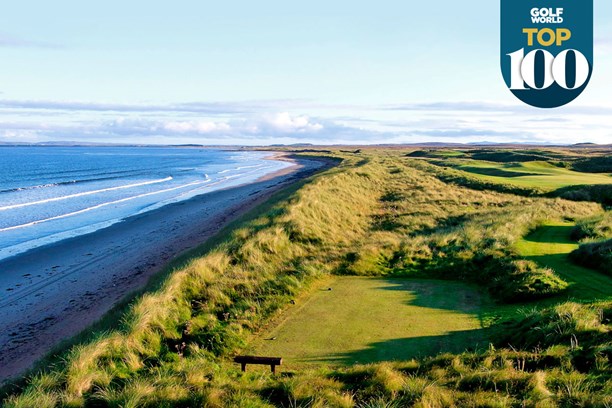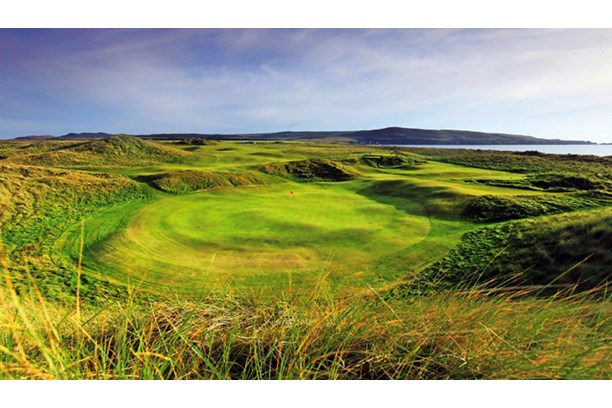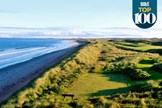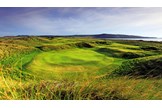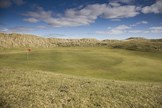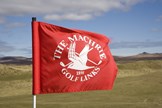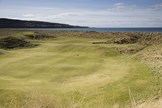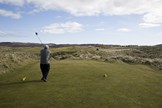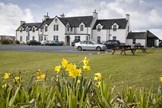Machrie Hotel & Golf Links
Last updated:
What we say
A golf course that requires a boat to reach it has to be pretty special, and The Machrie is just that. In fact, it’s one of the best courses in Scotland.
There are those who will never agree with the sweeping redevelopment of The Machrie. Even if the new course is widely considered a thoughtful reworking of a classic and prospers commercially, some will still bristle at the modernisation of one of Scotland’s most iconic and historic courses. When I heard it was being restored to such an extent, I certainly had at least one foot in that camp.
I was worried The Machrie would morph into just another excellent links, that it was going to lose the idiosyncrasies and atmosphere that made it unique. It wasn’t concern based on romantic whim; I had good reason to fear the magic may be lost.
COURSE REVIEW: Macrihanish Dunes Golf Club
I travelled to the Hebridean island in 2008 for a memorable couple of days that were disguised as the ‘stag’ of a friend. We also played Turnberry’s Ailsa and Dundonald (in fact, of the three courses we played, only the latter – and happily the marriage – remain in tact).
The Ailsa was naturally a thrill for everyone, but The Machrie was the centrepiece of the trip. Most of the 12-strong party loved the journey to Islay by boat from Troon. Everyone loved the boozy meal around a stout wooden table in the small hotel’s cosy dining room, and many had a good go at the hundreds of whiskies lined up behind the snug bar.
Most even insouciantly accepted the basic lodging of the rustic adjoining cottages, memorable for the ‘chintz’ decor and slightly brown, peaty bath water.
And everyone really loved The Machrie’s unconventional course, eccentric even by the standards of a remote Scottish links. The whole place had a ramshackle feel yet one bursting with authenticity and appeal. I reflect now on those two days fondly, and I am pretty sure the 11 others do too.
COURSE REVIEW: The Carrick
The truth, however, was that The Machrie was quietly failing. Thinking back now, through the mists of the famous Islay malts, and it was obviously the case. Simply, not enough golfers were intrepid enough to make the relatively long and awkward journey to Islay to play and stay there. One can only assume it was a bit too rustic, on and off the course, to lure golfers to this west of Scotland outpost.
It is against this background that everyone must surely consider the renaissance of The Machrie.
Its financial problems came to a head in 2010, when it entered administration. It needed new investment and probably a new ethos. Both came from an unlikely avenue; a former chairman of the BBC and his wife, the Director of Government Relations when Gordon Brown was in No.10. Gavyn Davies and Baroness Sue Nye bought The Machrie in 2011 for over a £1million and through mutual acquaintances, engaged long-time European Tour player turned architect DJ Russell to assess the links they’d purchased.
“I have always been obsessed with Scottish links and have played most of the notable courses,” Davies tells Golf World. “I played The Machrie a few times with my kids over the years, and loved it. When it went into administration, I worried it might close, and wanted to rescue it. I saw an opportunity to restore a great Scottish links to full health.
“Everything has taken longer than expected, but we are more and more excited about the potential. The delays have just given us more time to think carefully.”
Golf World Top 100: Best Golf Courses & Resorts
Initially, Russell intended merely to make some of the most exacting holes less severe. But evolution became revolution, with plans drawn up for such a wholesale redevelopment that the old course could still be played while the new one was being built alongside it.
Russell concluded the existing course, much (but, note well, not all) of which was created by Willie Campbell in 1891, was now not fit for purpose. Because Campbell routed his links over and round the dunes rather than through them, it gave The Machrie its infamously high number of blind shots. There were almost 20 (before you started to hit your ball out of position), including the iconic drive off the 7th, over a gargantuan fescue-covered hill that rose 60ft in the air directly in front of the tee.
Picking apart this centuries-old pedigree with such a drastic redesign was not something Davies did lightly.
“We spent a great deal of time agonising, but eventually decided changes were needed,” he says. “The course was short at 6,200 yards, and had been changed many times since it was first laid out by Campbell. So we did not have an original course to preserve anyway. The layout we inherited had about 17 blind shots and did not take full advantage of the incredible coastal setting.”
That is certainly not the case now. Russell’s routing has a much greater number of expansive views of the sea on the front nine. The internal out of bounds has also gone. Lots of the blind shots have too. So too have many of the low-lying bowl greens – useful in summer of a bygone age to retain water but, even on a sandy site, not helpful in winter – with the 1st, 4th and 7th the only real original survivors.
With the expertise and energy of Dean Muir – formerly deputy course manager at Muirfield, whose recruitment was a real coup – it is clearly going to be in terrific nick too.
But this is far from a sanitised version of the old crazy one. If you want blind shots, you will most likely get them, unless you are sufficiently skilled to plot your ball around the links. The difference now is that you will only have a blind shot if your tee shot was offline. So, the intriguing guesswork that comes with blind shots is still going to be a part of everyone’s round here, just not as standard.
This golfer is pleased that is the case, but it is a moot point as to whether the average punter really wants blinds shots. The kind of links connoisseur who was most likely to travel here in the past might more than most, but it’s probably quite likely there are less modern golfers who enjoy the randomness that was a necessity before. Would Campbell have done what Russell has, if he had had the ability to in the 1890s? It’s hard to imagine he wouldn’t.
Further increasing The Machrie’s playability are its now-wider fairways. “Where is the fun in hacking out of long grass, losing balls or constantly looking for balls?” asks Russell. Yet the width further increases the need for sound strategy and execution off the tee, in order to secure the best angle for your second. It’s not narrow and there are few bunkers – there are five now but might be as many as 10 – yet the new yardage of 6,782 and the breeze that will forever buffeted this linksland means it will always test. Crucially, though, for higher handicappers on inclement days, it will remain playable.
Around the green, it is all about options. You only find short grass covering the mounds, swales, ridges and gullies, with Russell eager to encourage creative thinking and traditional links fun. Don’t think this is now a flat, homogenised modern links with all its eccentricities stripped out, because the outstanding shaping – in other words, it looks natural – of the fairways and green complexes by Edinburgh Landscaping’s Eric Sammels are bursting with bewitching character.
So, anyone who hadn’t been before 2016 and hadn’t read about the redesign will not now leave wondering how The Machrie had a reputation for quirky features and memorable idiosyncracy. It oozes both, hole after hole, funky fairway after sporty green.
Highlights for this golfer include the extended dog-leg 2nd with a new beachside green site, the trio of par 4s from the 5th – towards then alongside the sea, but all very different – the short 9th (see previous page), the sporty two-shot 11th that takes you into a heathery section further inland, the stroke one 13th and short 14th.
Take it from someone who loved the old Machrie; the new version is just as fascinating. So go there with an open mind to experience what remains one of the most intriguing courses in Britain.
RELATED: Golf World Top 100 Links Courses in Great Britain and Ireland
-
Course Summary
- Costs -
- TG Rating
- Players Rating
- Address Port Ellen, , ISLE OF ISLAY
- Tel 01496 302310
- Website https://machrie.com/
Course Information
| Course | 72 par |
| Course Style | - |
| Green Fees | - |
| Course Length | 6,782 yards (6,201 metres) |
| Holes | - |
| Difficulty | - |
| Course Membership | - |
Course Features
- Course does not have: Bar
- Course has: Buggy Hire
- Course does not have: Driving Range
- Course does not have: Practice Green
- Course does not have: Pro Shop
- Course does not have: Restaurant
- Course does not have: Trolley Hire
- Course has: Dress Code
- Course does not have: Club Hire
- Course does not have: Handicap
Your Reviews
-
True links golf.
Love the course. Its an amazing totally natural layout where you thread your way through towering dunes. Some awesome holes and a couple of week ones (10th) especially. Greens are true and quicker than quick in the summer. Only down side is a lack of facilities for visitors unless you sre staying in the hotel. Special mention to Simon the greenkeeper who could not be nicer or more accomodating.
